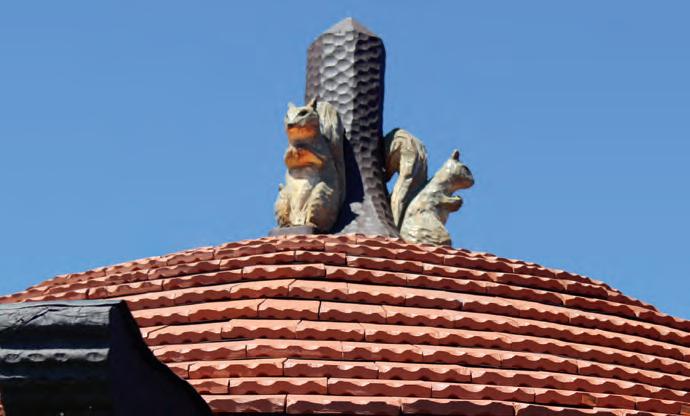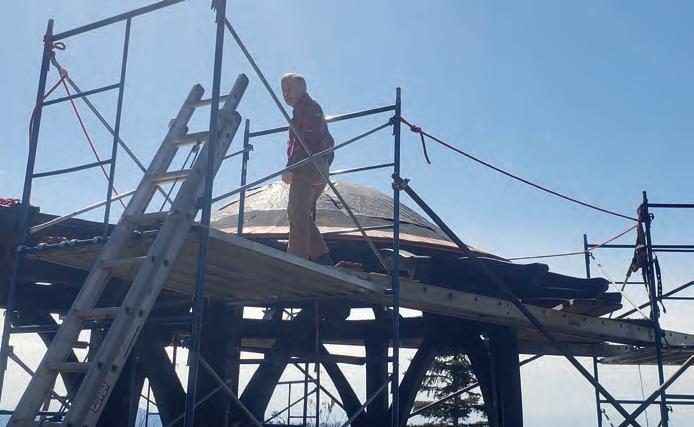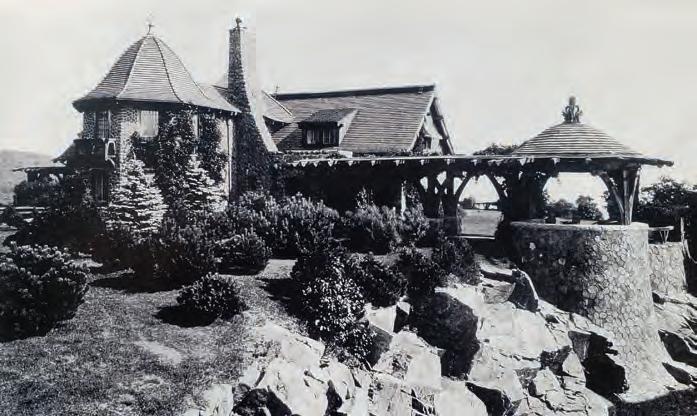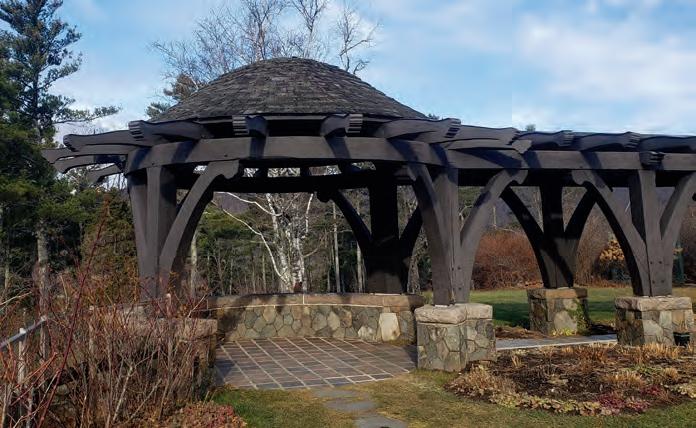
6 minute read
Bringing Back the Squirrels
Castle in the Clouds replaces its sentry rooftop rodents, who were discovered MIA in 2017
STORY & PHOTOS BY MARSHALL HUDSON
I’m up on the roof admiring the view from this usually off-limits vantage point. To the southwest, I see the blue shimmering water of Lake Winnipesaukee broken up by a multitude of wooded islands. To the northeast are the isolated Ossipee Mountains with their pitch pine barrens and scrub oak woodlands, which provide a colorful autumn display.
Ask anyone who has ever visited the Castle in the Clouds in Moultonborough, and they will likely speak fondly of these million-dollar views. The scenery gets even better when observed from high atop the castle’s roof. But I’m not up here to admire the view, I’m looking for squirrels. I’m not just looking for any squirrels, I’m looking for some elderly ones that wandered off and are returning today.
The squirrels were installed as a decorative finial on this roof about 1914. After nearly a century of sentry duty, they suddenly vanished. Today, I’m working alongside a restoration team intent on bringing them back. Historic black-and-white photographs show these old squirrels perched on the peak of the castle’s turret roof, located at the end of a pergola-covered walkway. But there are no records revealing why they are there. Perhaps it was done on a whim by Thomas Plant, the eccentric millionaire who built this retirement home he called “Lucknow,” now known as Castle in the Clouds.
Thomas Plant was born in Bath, Maine, in 1859 to French Canadian immigrants and was forced to leave school at the age of 14 to help support his family. Plant took a job as an apprentice in a shoe factory. An ambitious young man with talent and drive, Plant quickly rose from laborer to factory owner in only 11 years. He went on to establish his own company, and by 1910, his factory in Jamaica Plain, Massachusetts, was the largest shoe factory in the world. That same year, at the age of 51, Plant sold his business to the United Shoe Machinery Company and started making his retirement plans.
Plant retired to the Ossipee Mountains and began buying up land to build his dream home. He bought a small hotel and the surrounding acreage, followed by adjoining farms, an observation area called the “Crow’s Nest,” and a variety of other lodges, buildings and vacant land. He raised the structures on these acquisitions, and in 1913-1914, Thomas Plant and his wife, Olive, built their unique estate. They oversaw the construction of a 16-room granite veneer mansion with a horse stable, six-car garage, two gatehouses, a greenhouse, a manmade lake, a golf course and a tennis court. The estate eventually included 6,300 acres with 2 miles of lake frontage and a boat house on Lake Winnipesaukee.
For many years, Thomas and Olive Plant enjoyed a luxurious lifestyle at Lucknow with their large staff of caretakers, and the home’s state-of-the-art amenities, which included a central vacuum, ammonia-brine refrigerator and a house-wide interphone system. But by the early 1920s, due to a downturn in the economy, some bad investments and a habit of overpaying for their desired things, the Plants were no longer financially able to continue their lifestyle.
The Lucknow estate was mortgaged to a friend who allowed the Plants to continue to live there until Thomas’s death. The estate then went into foreclosure, and Olive returned to Illinois to live with her family. In 1956, the estate was sold to Mr. Richard Robie, who opened it as a tourist attraction and changed the name to Castle in the Clouds.
Since 2006, the castle has been owned and operated by the Castle Preservation Society, a private nonprofit corporation that opens it seasonally to the public. In 2017, the Preservation Society began restoring the covered walkway known as “the pergola” that leads from the driveway to the lakeside lawn. This pergola was in rough shape. Water damage and wood rot were wreaking havoc on the posts, beams, braces and decorative rafter tails. The clay tile roof needed replacing, and the historic squirrels had gone missing.
Preservation carpenters replaced only what was absolutely necessary with the goal of retaining as much of the original structure as possible. New white oak timbers were spliced onto the original ones using specialized joinery techniques. All finished surfaces were further shaped with hand chisels to resemble the scalloping on the original woodwork. New copper flashing was attached to the tops of the rafter tails to divert rainwater and prevent further rot.
Replacing the clay tile shingles on the pergola posed a challenge because the bellshaped roof curves in multiple directions simultaneously. Also, as each course or ring of tiles proceeds up the circular roof, a smaller shingle with a tighter radius is required. Every tile had to be individually crafted and numbered for installation in a designated spot on the turret roof.
A chainsaw artist in Pennsylvania was commissioned to carve three new squirrels out of white oak stumps, which was chosen for its natural, rot-resistant durability. Each squirrel stands about a foot and a half tall and appears to be holding an acorn. The squirrel carvings were shipped to New Hampshire, where a building restoration company, also carving with a chainsaw, created the finial pedestal that unites the squirrels and anchors them to the roof.
The roofing contractor invited me onto the roof as the clay tiles went down and the squirrels went up. I climbed the scaffolding, secured a safety harness and assisted with photo-documenting the restoration work.
When the last of the tiles were set in place, the replacement squirrels were hoisted onto the roof and installed at their prime viewing spot looking out over the castle grounds. The scaffolding came down, and my rooftop vantage point became off-limits once again.
If you visit the castle, you’ll have to enjoy the views from the ground, but don’t just gaze out at the mountains and lake, turn around and check out the squirrels guarding the castle from high atop the pergola roof.















